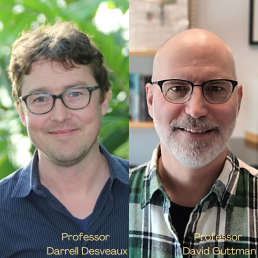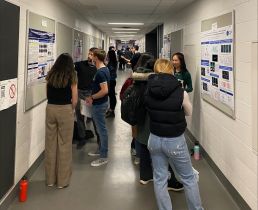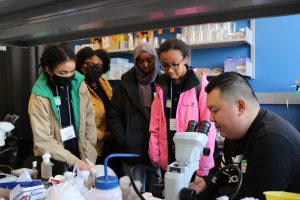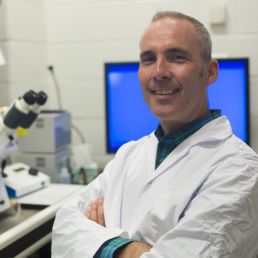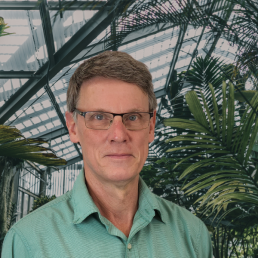Benign bacteria can cooperatively cause virulence
“In science, we often focus on a single ‘wild type’ organism, but even a single species of bacteria has as much variation as the instruments in a symphony. The French Horn produces a lovely sound, but if all you do is focus on French Horn, you’ll never know the joys of a symphony.” This is how Prof Darrell Desveaux of Cell & Systems Biology explains his approach to studying virulent bacteria.
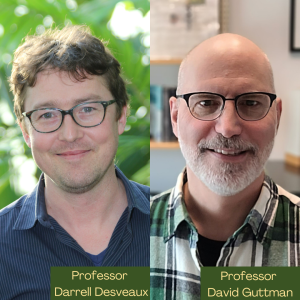 Desveaux and his colleague Prof David Guttman study plant infection by the Pseudomonas syringae bacteria. Their “systems-level” approach takes into account the natural diversity of this species. In a new study published in Nature Microbiology, they find that distinct bacteria living in a community are collectively able to provoke disease without any single bacterium being the cause.
Desveaux and his colleague Prof David Guttman study plant infection by the Pseudomonas syringae bacteria. Their “systems-level” approach takes into account the natural diversity of this species. In a new study published in Nature Microbiology, they find that distinct bacteria living in a community are collectively able to provoke disease without any single bacterium being the cause.
Graduate student Tatiana Ruiz-Bedoya conducted these experiments in the Desveaux and Guttman labs. “I find it fascinating that P syringae is found wherever there is water, including in clouds and snow. The versatility of P syringae to survive in each of these ecological niches makes it a species complex with different evolutionary pressures in each niche.”
The most consequential niche to humans is within plant leaves, which can be infected by P. syringae to extract extra resources that help the bacteria grow. “The community of P syringae researchers is a huge benefit for us,” asserts Guttman, “The genomics, ecology, and pathology are well-established, and the resources and tools we have developed make the system easy to manipulate. The insights we gained in this study would not be currently possible with any other plant or animal pathogen..”
Infection carries risk for the bacteria since they must evade the immune system of the plant host. P. syringae employs a diverse array of “effector” proteins to support bacterial growth (virulence) by suppressing the plant immune system. This new research assesses the ability of effectors from separate individuals to work in concert in causing virulence in the plant Arabidopsis.
The commonly used Pst strain DC3000 has 36 effectors. Ruiz-Bedoya started with a strain that is non-virulent due to its lack of effectors. She created a 'metaclone' with one effector per bacteria in a culture that contained all 36 effectors. Each individual strain of bacteria in the metaclone is non-virulent, but she hypothesized that effector functions within the community of bacteria would drive the emergence of virulence in the invading population.
When Ruiz-Bedoya sprayed her metaclone on Arabidopsis leaves, the effector metaclone was indeed virulent, demonstrating the cooperative benefit of this approach to evading the immune response for the bacterial community. She then tested the effect on the community of adding a single strain that provoked an immune response. She found that growth of all bacteria was suppressed. Effectors can thus act as against the community when they trigger an immune response.
Desveaux is excited by how this revelation changes our view of virulence. “You can have a single pathogen that is a one-man band of virulence, but we’ve shown that virulence can come from a symphony of individually ineffective strains that together cause virulence and evade immune detection.”
The full details are available at "Cooperative virulence via the collective action of secreted pathogen effectors"
Oustanding CSB educators earn 2022-23 TA Teaching Awards
Congratulations to the recipients of the 2022-23 CSB TA Teaching Excellence Award! This award recognizes the significant role of Teaching Assistants in the Department of Cell and Systems Biology and their key contributions to the learning experience of students.
This year, the award was earned by graduate students Kevin Xue (CSB350), Tatiana Ruiz-Bedoya (BIO260) Christine Nguyen (BIO130/230) and Ernest Liang (BIO130) based on feedback from undergraduate students in their tutorials.
“I was surprised to learn I was chosen for this award, and grateful that the students showed this faith in me” remarks Nguyen. She confides that she vividly remembers what it was like to be in first year and tries to apply that experience to her teaching.
“I am also grateful” says Xue. “I enjoy working with the students as a TA and it makes me glad to see how their comprehension of the subject grows over time.”
Liang observes that teaching is beneficial for him as well as for his students. “The class is coming to the field fresh so they ask unexpected questions of surprising depth. In formulating a comprehensive answer, I come to understand the topic in a deeper way.”
Ruiz-Bedoya notes of her students, "This course is their first contact with most concepts in genetics so it is inspiring to see their dedication and devotion to learning them in such depth, it makes it all the more fun to find new ways to help them.”
TAs are nominated by undergraduate students enrolled in their course and evaluated based on the following criteria:
• Demonstrates a keen interest and enthusiasm towards teaching and learning
• Ability to effectively organize, structure and facilitate learning in the classroom, tutorials or labs
• Actively engages, motivates, and challenges students
• Uses teaching practices that advance accessibility, equity, diversity, and inclusion
• Demonstrates depth of knowledge in the subject and effectively communicates complex concepts to students
• Utilizes innovative teaching strategies and tools
• Provides timely and constructive feedback to students
Congratulations to these outstanding educators!
CSB project students present their year's work in research
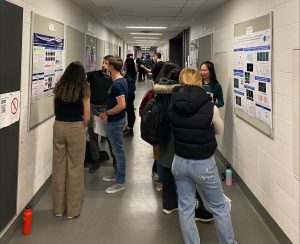 A year of research by CSB project students culminated in a poster session on March 31st, 2023. The students used the posters to describe their research and results, while answering questions from peers and professors. This presentation represents the final step of their CSB497/498 course.
A year of research by CSB project students culminated in a poster session on March 31st, 2023. The students used the posters to describe their research and results, while answering questions from peers and professors. This presentation represents the final step of their CSB497/498 course.
Presentations were assessed based on the descriptions given by students and on the ability of students to respond to questions. Outstanding presentations were awarded the F Michael Barrett award. Undergraduate Chair Dinesh Christendat revealed that "It was a challenge for the judges to assign these awards, since all the presentations were impressive."
Angitha Mriduraj studied "Characterizing the Impact of Camsap2a Knockout on Patterning genes during Zebrafish Epiboly" in the Bruce lab. The Bruce lab studies how the complex and varied body plans of animals are generated during embryonic development.
Arthur Siu studied how "Intracellular Calcium is Necessary for Viscosity-dependent Cell Migration" in the Plotnikov lab for his award. The Plotnikov lab aims to uncover how migration of animal cells is controlled by mechanical signals form the extracellular environment.
Yutei Shi earned his award for "From Enhancer Sequence to Function: Validating Novel Neural Network Predictions on Contribution of Motifs and Motif Copy Number" in the Mitchell lab. The Mitchell lab studies how the genome functions in stem cells to regulate self-renewal and differentiation.
Smera Mehta worked on "Testing a new single copy transgenesis method in C. elegans" in the Calarco lab to earn her award. The Calarco lab studies post-transcriptional gene regulation in the nervous system.
There were two awards for research in the Saltzman lab which studies the role of chromatin regulation in establishing and maintaining the gene expression differences that underlie cellular identity. Sofia Eiras earned her award for "Histone H2A monoubiquitylation by Polycomb Repressive Complex 1 in C. elegans nervous system development" and Aly Muhammad Al-Karim Ladak won for "Guardians of the epigenome? The role of the histone methylation readers CEC‐3 and CEC‐6 in heterochromatin establishment and repetitive element silencing".
Evan Berthelot earned an award for research in the McFarlane lab on "Investigating the Role of Auxin in Cell Wall Synthesis". The McFarlane lab researches plant growth and development and the fundamental mechanisms by which plants sense their environment and adjust their growth in response.
Congratulations to everyone who came out to present, and especially to our outstanding award winners!
Pursue STEM provides an introduction to Cell & Systems Biology for Black high school students
Professor Ritu Sarpal, the CSB Liaison for Pursue STEM, organized an outreach event on March 14th as part of our EDI committee’s efforts to encourage minority groups to pursue higher education in the biological sciences. Pursue STEM is a program that supports Black high school students interested in STEM fields which is delivered in partnership with Leadership by Design (LBD), UofT’s Office of Student Recruitment, and other Departments within the Faculty of Arts and Sciences.
As part of this event, high school students were introduced to ongoing cutting-edge research activities in CSB via short talks and a tour of our imaging facility, following which they visited the Calarco, Plotnikov, and Harris labs (as shown above, in order). Kudos to our graduate students, Jeffery Stulberg, Pallavi Pilaka, Bina Sugumar, Ernest Iu, Fernando Valencia, Leo Xu, Vanessa Ghorayeb, and scientific staff members, Dr. Kenana Al Kakouni, and Audrey Chong, who made this event a big success!
When asked to comment about their CSB department visit, students responded:
"I really enjoyed the visit to the CSB department. I found it very engaging and interesting. The range of research topics and methods was cool and exciting. It was very inspiring."
"I most enjoyed the molecular biology lab [Plotnikov lab] and observing the worms under the microscope [Calarco lab]. All of the facilitators were so helpful and fun too!"
"I learnt a lot about the different types of model organisms. I most enjoyed viewing fibroblasts under the microscope [Plotnikov lab] and looking at fruit flies [Harris lab]"
"Events like this could help to encourage minority groups to pursue higher education in the biological sciences," says Professor Sarpal, who is also conducting two hands-on workshops in April for Pursue STEM students to perform regeneration experiments on flatworms.
Janssen Award for Equity and Inclusion to improve opportunities for CSB graduate students
CSB is grateful for a new endowment to U of T from Jannsen Canada that will help address health inequity and provide ongoing support to future leaders in healthcare.
The Janssen Award for Equity and Inclusion supports Faculty of Arts & Science undergraduate and graduate students, with a focus on Black and Indigenous students.
"Janssen's endowment serves a crucial role in fostering a community in which learning and scholarship can flourish," says CSB Chair Nicholas Provart. "We are glad for this opportunity to allow future generations - regardless of background - to seize opportunities in Cell & Systems Biology"
The graduate award supports a PhD student in the Department of Cell & Systems Biology based on academic merit and financial need, while the undergraduate award in the Human Biology Program is based on financial need.
Professor Kenneth Yip teaches many first year undergraduates and is Chair of CSB's EDI Committee. “We recognize that promoting equity and inclusion in our department is essential to achieving our mission," says Yip, "This endowment will help create a more diverse and inclusive learning environment that supports the success of all students.”
You can read more about this important endowment in "Janssen Funds for Equity and Inclusion will help remove barriers to education"
Important tips on communicating with your busy Principal Investigator
Professors are passionate about their research topic and the trainees who do the experiments are key, but supervision must compete with all their other responsibilities. These "Principal Investigators" need to write grants for research money, budget for spending their funds on research, write up the results of their research, teach large classes, and help run the University.
Ben Tsang is an experienced lab manager and now a first year CSB grad student in Prof Robert Gerlai's lab at University of Toronto Mississauga. In the Careers section of Nature Magazine, he shared his advice on efficient communication with your busy supervisor. You can read more through this link.
Congratulations on this article, Ben!
Tatiana Ruiz-Bedoya's passion for science yields Dr Christine Hone-Buske Scholarship
The Dr Christine Hone-Buske Scholarship honours an Outstanding Publication by a PhD Student in Cell & Systems Biology. This year’s award goes to Tatiana Ruiz-Bedoya for her work on “Cooperative virulence via the collective action of secreted pathogen effectors”.
Ruiz-Bedoya acquired an appreciation of natural diversity in her home city of Bucaramanga, Colombia and the nearby Chicamocha Canyon. From an early age, she sought to understand the natural world through science, proceeding to her current doctoral studies in Cell & Systems Biology.
In moving within the academic world through Bogotá, Uppsala, Munich and Boston prior to Toronto, Ruiz-Bedoya accumulated a prodigious amount of experience in genetics. Her interests range from identifying trafficked endangered animals through DNA to evolutionary genetics of phlox flower colour.
Ruiz-Bedoya was intrigued by research showing that the arms race between pathogens and host leads to rapid evolutionary changes. This passion led her to the Gutttman and Desveaux labs in Toronto, which study the host-pathogen response between plants and the bacteria Pseudomonas syringae.
Most plant pathology studies focus on individual strains found at high frequencies during outbreaks. But Ruiz-Bedoya notes that P syringae is an extremely diverse species complex with a life cycle that moves from clouds in the sky to soil surrounding potential plant hosts. Through this life cycle, there could be wide variation in virulence.
Ruiz-Bedoya and her lab colleagues reasoned that a focus on individual strains added bias to the way virulence was assessed. Within a carefully constructed community of non-virulent bacteria, they found that virulence could indeed emerge as a collective phenotype irreducible to its components.
Ruiz-Bedoya’s results form the very first proof-of-principle on the emergence of cooperation-driven virulence through the collective action of virulence factors. The findings of her award-winning research with Dr Pauline Wang, Prof David Guttman and Prof Darryl Desveaux was published in Nature Microbiology.
Ruiz-Bedoya attributes her success to stubbornness and to a determination instilled by her mother to go above and beyond. She is excited by science and her passion for research is something she emulates from seeing it in her many mentors. “Some of these qualities can be as helpful as they can be upsetting, especially when experiments don't work”, says Ruiz-Bedoya, “But you must be determined to find the balance within your life and I am very privileged that I get to do science for a living.”
With additional roles as a teaching assistant, communicator and friend, Tatiana reflects the spirit of Dr Christine Hone-Buske, who approached her work as a student, teaching assistant, and researcher at U of T with confidence, curiosity and drive.
Congratulations, Tatiana Ruiz-Bedoya, on your Dr. Christine Hone-Buske Scholarship for Outstanding Publication by a PhD Student!
Mitchell lab reveals redundant systems that maintain genome architecture
Redundancy ensures integrity of gene expression independent of genome architecture
Part of finding out how something works is trying to break it. Two recent papers from Professor Jennifer Mitchell’s lab try to break the folded structure in the genome that links the essential Sox2 gene with its far away regulators. But no matter how many elements they removed or added around the Sox2 region, this structure was maintained, revealing the depths of the redundant systems that protect genome integrity.
Sox2 is crucial for the identity of embryonic stem cells. Dr Ian Tobias, a postdoctoral fellow in the Mitchell lab in Cell & Systems Biology, notes that “It makes a lot of sense, from an evolutionary and developmental biology standpoint, that such a key regulator of cell fate wouldn't be so fragile as to have its regulatory control lost with the deletion of a small segment of DNA.”
Sox2 and its distant control region are bundled together
Inside our cells the genome consists of long ribbons of DNA that contain all the information to make every part of the body. In organs like lung or brain, the DNA is fenced off in different ways to turn on lung or brain-specific genes, while hiding genes that should not be active. The Sox2 gene region is open and active in embryonic stem cells but closed in most other cell types.
Active Sox2 in embryonic stem cells is isolated within a region that contains only the gene and its activators including the Sox2 Control Region (SCR). The SCR is over 100,000 base pairs away from Sox2, so this region is relatively long. Individual organised regions of the genome have been called topologically associated domains (TAD), and the Mitchell lab studies how these domains are established and maintained.
Tiegh Taylor, a PhD student in the Mitchell lab used gene editing to tease out the mechanisms that keep the Sox2-SCR gene domain intact. Working with colleagues in the Sexton lab in Strasbourg, France, their studies of the region around Sox2 challenged the dogma of how the winding ribbons of DNA in a cell are organized.
In large scale studies of the genome, the CTCF protein is almost always found at TAD boundaries, leading to the idea that CTCF-bound DNA acts as a fence that isolates DNA outside of the domain from DNA inside the domain. Separate transcription factor proteins are responsible for individual gene activation, bundling DNA within the TAD together.
CTCF is not required for Sox2 TAD maintenance
What the Mitchell and Sexton labs showed is that transcription factor proteins can still keep DNA organized in embryonic stem cells even in the absence of the CTCF fences.
How did they show this? The SCR is comprised of two clusters of transcription factor binding sites flanking a CTCF site. At the Sox2-SCR loop, transcription factor proteins interact to enhance gene activation, giving the SCR the designation of an “enhancer”.
When the researchers removed the transcription factor-binding clusters, Sox2 enhancement was lost, but the TAD bundle remained in place. Removing all of the SCR including the CTCF site loosened the bundle to interact with an adjacent TAD, so presumably CTCF is holding the TAD together.
Surprisingly, Taylor found that although this CTCF site was sufficient to fence in the TAD, it wasn’t necessary. When removed from the SCR, the TAD bundle was maintained, presumably due to the transcription factors binding to the enhancer surrounding the missing CTCF binding site. The strength of these transcription factors is so strong in fact, that they are able to ‘jump over’ an artificial CTCF fence which was later placed between Sox2 and the SCR.
Taylor notes that “It wasn’t clear what the finding was at first, as the data came in it seemed like nothing we could do would break this interaction. It wasn’t until we thought about it for a while that we realized that maybe it’s not that these various proteins are so defined in their roles of interaction vs enhancer, it’s more about this complex cooperativity between all these factors that makes this locus so robust. It really highlights just how complicated our genome is.”
This work was published in the journal Genes & Development as “Transcriptional regulation and chromatin architecture maintenance are decoupled functions at the Sox2 locus”
Transcription factors maintain Sox2 architecture, even as stem cells become neural progenitors in mice
Taylor’s colleague Dr Ian Tobias is studying what happens to enhancer activity when embryonic stem cells change into other cell types where Sox2 is active. “We're interested in the neural lineage because it's also highly dependent on the Sox2 protein; the model we use is neural progenitor cells (NPS). During the differentiation of embryonic stem cells to NPS, Sox2 interacts with a region that’s even further away than the SCR.”
Using techniques similar to Taylor’s approach, Tobias found that when the far away region is deleted, Sox2 doesn’t turn on in NPS, making this site a candidate Sox2 distal neural enhancer or DNE. At the same time, collaborators at the NIH in Maryland were looking at TADs in neurons and saw a clear domain linking the DNE to Sox2. When the NIH group blocked TAD formation in mice by inserting CTCF between the DNE and Sox2, interaction was reduced, but not eliminated, again showing how robust these interactions can be.
The result of this collaboration has been published in Nature Genetics as “Enhancer–promoter interactions can bypass CTCF-mediated boundaries and contribute to phenotypic robustness”.
New targets for understanding genome architecture and disease
The combined results in these two papers reveal that specific elements supplying enhancer function contribute to maintaining DNA structure. They consequently argue for looking beyond CTCF when looking to explain how DNA folds in the nucleus.
Professor Mitchell notes that “Now that we know these enhancer sequences are important for regulating Sox2 during development, our next steps are studying aberrant expression of Sox2 in disease.” Tobias and others in the Mitchell lab will be pursuing the role of Sox2 enhancers and their associated proteins in neurological disorders and other diseases.
Professor John Peever earns Distinguished Scientist Award from the Canadian Sleep Society
Professor John Peever is this year’s recipient of the Canadian Sleep Society's (CSS-SCS) Distinguished Scientist Award.
This award recognizes a clinician or scientist who has made significant national and international contributions to the field of sleep medicine and biology. The recipient is invited to give a Keynote address at the CSS-SCS National Conference, held this year on April 27-29 in Ottawa.
Research in Peever's lab is focused on identifying the brain circuits that control sleep and wakefulness, and how breakdown in these circuits contribute to disorders such as Parkinson’s disease and narcolepsy. He is also a strong advocate for promoting the awareness of sleep in health and disease.
Peever asserts that "It’s an honour to receive this recognition but all the credit goes to my outstanding team of trainees!" You can read more about Peever and his trainees' work in this story: "U of T neurobiologists discover switch that turns muscles on and off", and in Research 2 Reality's video profile: "What goes into a good night's sleep?"
Congratulations, Professor Peever!
Sustainability award to Chief Horticulturalist Bill Cole for greenhouse energy improvements
U of T's Chief Horticulturalist, Bill Cole, has led the change for energy efficiency in our plant growth facilities through relentless effort on lighting retrofits. Cole's work has earned him the Sustainable Action Award from Facilities and Services.
Plant science requires tightly controlled temperature and lighting, whether in a growth chamber or a greenhouse, but the power demands for these conditions can approach industrial levels. Earth Sciences Building greenhouses contain specimens representing hundreds of plants in specialized environments to mimic desert, tropical and temperate zones.
In 2021, Cole's team retrofitted one zone of the Earth Sciences Building greenhouses from old yellow sodium lamps to LED panels. This pilot project reduced energy consumption and lowered heat output. There was an added benefit of more blue and red wavelengths to enhance growth of research and teaching plants. The improved lighting will allow growth of light-hungry research plants from Brazil and South Africa.
Goldleaf Technologies has provided 200 Thrive LED Grow Lights to retrofit all 15 greenhouse zones with LED panels starting in January 2023. Goldleaf notes that their LED lights provide over 50,000 hours of light, losing only a fraction of intensity over their lifespan compared to obsolete lighting systems that require frequent repair.
The Greenhouse facility operation team has the experience to operate this specialty lighting and has developed a detailed schedule to upgrade them. The new LED panels will be installed over two months, gradually changing the yellow glow atop the Earth Sciences Building to a more even hue. This will reduce energy consumption by 33%, moving toward U of T's goal to be net Carbon positive by 2050.
Cole donated a portion of his Sustainable Action Award to Sustainability Network, whose mission is to strengthen environmental nonprofit leadership.
Congratulations, Bill Cole!

